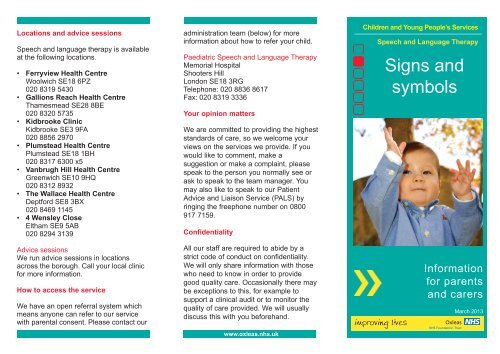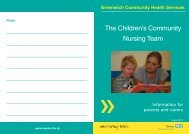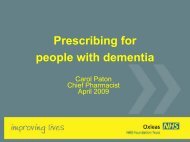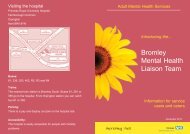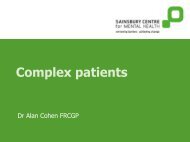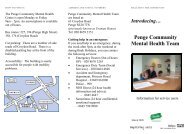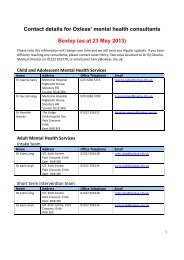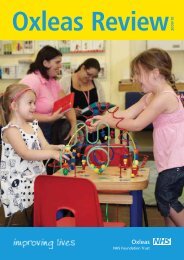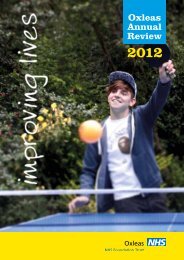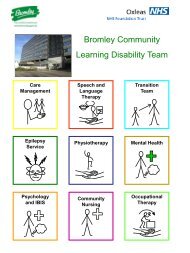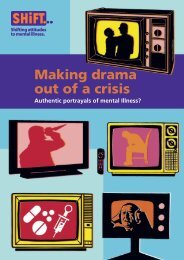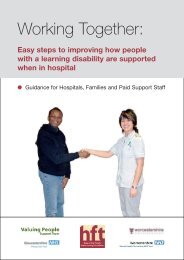Signs and Symbols leaflet
Signs and Symbols leaflet
Signs and Symbols leaflet
You also want an ePaper? Increase the reach of your titles
YUMPU automatically turns print PDFs into web optimized ePapers that Google loves.
Locations <strong>and</strong> advice sessions<br />
Speech <strong>and</strong> language therapy is available<br />
at the following locations.<br />
• Ferryview Health Centre<br />
Woolwich SE18 6PZ<br />
020 8319 5430<br />
• Gallions Reach Health Centre<br />
Thamesmead SE28 8BE<br />
020 8320 5735<br />
• Kidbrooke Clinic<br />
Kidbrooke SE3 9FA<br />
020 8856 2970<br />
• Plumstead Health Centre<br />
Plumstead SE18 1BH<br />
020 8317 6300 x5<br />
• Vanbrugh Hill Health Centre<br />
Greenwich SE10 9HQ<br />
020 8312 8932<br />
• The Wallace Health Centre<br />
Deptford SE8 3BX<br />
020 8469 1145<br />
• 4 Wensley Close<br />
Eltham SE9 5AB<br />
020 8294 3139<br />
Advice sessions<br />
We run advice sessions in locations<br />
across the borough. Call your local clinic<br />
for more information.<br />
How to access the service<br />
We have an open referral system which<br />
means anyone can refer to our service<br />
with parental consent. Please contact our<br />
administration team (below) for more<br />
information about how to refer your child.<br />
Paediatric Speech <strong>and</strong> Language Therapy<br />
Memorial Hospital<br />
Shooters Hill<br />
London SE18 3RG<br />
Telephone: 020 8836 8617<br />
Fax: 020 8319 3336<br />
Your opinion matters<br />
We are committed to providing the highest<br />
st<strong>and</strong>ards of care, so we welcome your<br />
views on the services we provide. If you<br />
would like to comment, make a<br />
suggestion or make a complaint, please<br />
speak to the person you normally see or<br />
ask to speak to the team manager. You<br />
may also like to speak to our Patient<br />
Advice <strong>and</strong> Liaison Service (PALS) by<br />
ringing the freephone number on 0800<br />
917 7159.<br />
Confidentiality<br />
All our staff are required to abide by a<br />
strict code of conduct on confidentiality.<br />
We will only share information with those<br />
who need to know in order to provide<br />
good quality care. Occasionally there may<br />
be exceptions to this, for example to<br />
support a clinical audit or to monitor the<br />
quality of care provided. We will usually<br />
discuss this with you beforeh<strong>and</strong>.<br />
www.oxleas.nhs.uk<br />
Children <strong>and</strong> Young People’s Services<br />
Speech <strong>and</strong> Language Therapy<br />
<strong>Signs</strong> <strong>and</strong><br />
symbols<br />
Information<br />
for parents<br />
<strong>and</strong> carers<br />
March 2013
What is a sign?<br />
A sign is a h<strong>and</strong> gesture that represents<br />
an object, action or idea. A sign is always<br />
used with the spoken word, natural facial<br />
expression <strong>and</strong> body language.<br />
What is a symbol?<br />
A symbol is an object, photo or picture<br />
that represents an object, action or idea.<br />
A symbol is always used with the written<br />
word.<br />
How do signs <strong>and</strong> symbols help?<br />
<strong>Signs</strong> <strong>and</strong> symbols give your child<br />
something to feel <strong>and</strong> to look at. They<br />
can help him or her to make the<br />
connection between a spoken word <strong>and</strong><br />
its meaning.<br />
Spoken words are invisible <strong>and</strong> disappear<br />
as soon as they are said. <strong>Signs</strong> <strong>and</strong><br />
symbols can be seen clearly <strong>and</strong> made to<br />
stay in one place.<br />
We all use signs <strong>and</strong> symbols in our daily<br />
lives, such as:<br />
• waving to a friend to catch their<br />
attention<br />
• following a road sign to find our way<br />
• using a calendar to remember<br />
appointments.<br />
When do signs <strong>and</strong> symbols help?<br />
<strong>Signs</strong> <strong>and</strong> symbols can help your child’s<br />
learning in areas such as:<br />
• communicating with others<br />
• concentrating <strong>and</strong> listening<br />
• underst<strong>and</strong>ing what others say<br />
• saying words <strong>and</strong> sentences<br />
• reading <strong>and</strong> writing<br />
• controlling his/her own behaviour<br />
• carrying out activities independently<br />
• developing self-confidence.<br />
<strong>Signs</strong> <strong>and</strong> symbols may be particularly<br />
helpful for your child if he/she:<br />
• learns best by touching <strong>and</strong>/or looking<br />
• is learning English as an additional<br />
language<br />
• has a speech, language <strong>and</strong>/or<br />
communication delay or difficulty<br />
• has hearing difficulties<br />
• has learning difficulties<br />
• is developing strategies to deal with a<br />
stammer.<br />
How signs <strong>and</strong> symbols help language<br />
development<br />
<strong>Signs</strong> <strong>and</strong> symbols will support your<br />
child’s speech <strong>and</strong> language<br />
development.<br />
When you use signs <strong>and</strong> symbols as you<br />
speak with your child, your language<br />
becomes easier for your child to<br />
underst<strong>and</strong> <strong>and</strong> to learn. You will speak<br />
more slowly, use shorter <strong>and</strong> simpler<br />
sentences, <strong>and</strong> make the important<br />
words st<strong>and</strong> out.<br />
Your child will need signs <strong>and</strong> symbols to<br />
be used in a way that is right for him/her.<br />
Ask your speech <strong>and</strong> language therapist<br />
for advice <strong>and</strong> ideas.<br />
How to use signs <strong>and</strong> symbols<br />
When you use signs <strong>and</strong> symbols with<br />
your child remember to:<br />
• get down to your child’s level <strong>and</strong> use<br />
eye contact to gain his/her attention<br />
• only use signs or symbols for the<br />
important words, such as “Do you want<br />
a biscuit or a banana?”<br />
• always use the same sign or symbol<br />
for the same object, action or idea<br />
• always say the word at the same time<br />
as you use a sign or symbol<br />
• give your child enough time to look at<br />
the sign or symbol<br />
• use signs <strong>and</strong> symbols during your<br />
daily routine in as many different<br />
situations as possible<br />
• praise your child for any language that<br />
he/she uses<br />
• have fun.<br />
Other useful information<br />
www.talkingpoint.org.uk offers plenty of<br />
useful information about speech,<br />
language <strong>and</strong> communication<br />
development.


